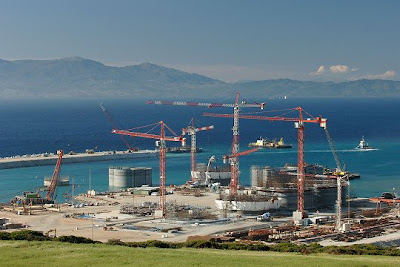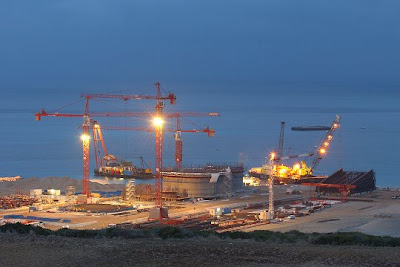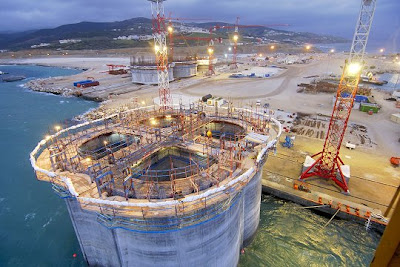samedi 21 mars 2009
Le Maroc à chantiers ouverts
Les grands projets de construction au Maroc vont de l’avant comme prévu, tandis que de nouveaux projets issus du secteur public et privé voient le jour.
L’année 2009 verra la réalisation d’un certain nombre d’améliorations dans les principales agglomérations ainsi qu’une mise à niveau des infrastructures à travers le Royaume, notamment grâce à la mise en œuvre de nouvelles stratégies d’urbanisation. En dépit d’une conjoncture économique internationale incertaine, les mégaprojets se déroulent comme prévu au Maroc. Saïda, le projet phare du Plan Azur, un investissement engagé par le gouvernement portant sur la construction de six nouvelles stations balnéaires le long des côtes atlantique et méditerranéenne, devrait être inauguré cet été, et comptera 29 hôtels et une capacité d’hébergement totale de 30.000 lits. De même, Morocco Mall, qui sera à terme le plus grand centre commercial de l’Afrique du Nord moyennant un investissement de 250 millions de dollars, devrait ouvrir ses portes en 2010 comme convenu, tandis que la société saoudienne Siama, dotée d’un capital de 85 millions de dollars, entamera cette année à Marrakech la construction d’un complexe hôtelier qui offrira un terrain de polo.
«C’est le moment idéal pour les constructeurs car le coût des matériaux de construction connaît une forte baisse en raison du ralentissement de l’économie», a déclaré Ammar Abdelhadi, directeur général de Siama, à la presse locale. Il a ajouté que le groupe était susceptible d’économiser jusqu’à 30% si les travaux commençaient sur le champ.
Le secteur public est tout aussi dynamique, avec plusieurs projets de construction prévus au cours des 11 prochains mois. Au cours d’une cérémonie à Tanger le 7 janvier dernier, le Roi Mohammed VI a révélé les détails de la prochaine phase de développement du complexe Tanger-Med, une zone portuaire commerciale et industrielle sur les berges du détroit de Gibraltar. Cette nouvelle phase de développement porte sur la mobilisation de 3.000 ha de terrains qui seront partie intégrante de la plate-forme industrielle. Dans le cadre de l’extension du port, le Terminal 2 a été mis en service et les terminaux 3 et 4 entreront en service en 2012.
Deux jours plus tard, le Roi Mohammed VI donnait le coup d’envoi des travaux de réalisation de la troisième tranche de développement de la zone franche de Tanger, d’un coût de 430 millions de dirhams (50,74 millions de dollars). Le programme d’investissement, au titre de la troisième tranche, porte sur l’aménagement et la viabilisation d’une zone réservée aux équipements automobiles (80.000 m2), la construction de 50.000 m2 de bâtiments industriels et la réalisation d’une zone tertiaire constituée d’espaces communs (restaurants et salle de conférence).
Par ailleurs, Al Omrane, la société d’aménagement publique, a récemment lancé la construction dune nouvelle ville près de Tanger. Bapisée «Ch’Rafate», elle offrira une gamme de logements diversifiés, une zone industrielle, des espaces verts ainsi que des écoles et des hôpitaux. Ch’Rafate sera construite moyennant un investissement de 2,9 milliards de dollars dans le cadre du programme «Villes nouvelles» engagé par le Royaume, qui envisage la création de 15 nouvelles villes afin de désengorger ses agglomérations saturées, en particulier les villes côtières. Ch’Rafate sera réalisée sur 1300 hectares d’ici 2020 et offrira quelque 30.000 nouveaux logements à près de150.000 habitants. La question du développement urbain marocain est devenue pressante, alors que la croissance économique du Royaume alimente les villes d’un flux massif de nouveaux habitants.
Le gouvernement a récemment publié sa Stratégie nationale de développement urbain (SNDU), selon laquelle 59% de la population du Royaume vit en ville tandis que plus de 1 million de Marocains ont quitté leurs villages pour s’installer dans des zones urbaines entre 1994 et 2004.
Signe d’une volonté de progrès continu, le gouvernement a récemment achevé la réhabilitation de 30 villes dans le cadre de son programme «Villes sans bidonvilles», qui entend déloger quelque 280.000 ménages vivant actuellement dans l’un des 70 bidonvilles du pays pour leur attribuer une habitation sociale.
Les infrastructures constituent un autre volet prioritaire.
Le réseau autoroutier marocain continue de s’étendre rapidement, et atteint actuellement 900km de long. Après l’inauguration du nouvel axe autoroutier Marrakech-Chichaoua le 5 janvier dernier, ont commencé les travaux portant sur l’extension de la route reliant Rabat à Casablanca, estimés à 120 millions de dollars. Au terme de ce chantier, un tronçon d’une longueur de 57,3 km connaîtra un élargissement à 6 voies.
Si la mauvaise conjoncture économique internationale est source de pessimisme, certains restent optimistes.
Selon Mourad El Bied, PDG d’El Alami Holding, les défis actuels constituent une réelle opportunité pour consolider le secteur. «Ces dernières années ont vu une arrivée massive de nouveaux constructeurs sur le marché qui ont acheté des terrains et ont commencé à construire. Aujourd’hui, ils se retrouvent dans une situation difficile», a déclaré M. El Bied à OBG.
L’année 2009 verra la réalisation d’un certain nombre d’améliorations dans les principales agglomérations ainsi qu’une mise à niveau des infrastructures à travers le Royaume, notamment grâce à la mise en œuvre de nouvelles stratégies d’urbanisation. En dépit d’une conjoncture économique internationale incertaine, les mégaprojets se déroulent comme prévu au Maroc. Saïda, le projet phare du Plan Azur, un investissement engagé par le gouvernement portant sur la construction de six nouvelles stations balnéaires le long des côtes atlantique et méditerranéenne, devrait être inauguré cet été, et comptera 29 hôtels et une capacité d’hébergement totale de 30.000 lits. De même, Morocco Mall, qui sera à terme le plus grand centre commercial de l’Afrique du Nord moyennant un investissement de 250 millions de dollars, devrait ouvrir ses portes en 2010 comme convenu, tandis que la société saoudienne Siama, dotée d’un capital de 85 millions de dollars, entamera cette année à Marrakech la construction d’un complexe hôtelier qui offrira un terrain de polo.
«C’est le moment idéal pour les constructeurs car le coût des matériaux de construction connaît une forte baisse en raison du ralentissement de l’économie», a déclaré Ammar Abdelhadi, directeur général de Siama, à la presse locale. Il a ajouté que le groupe était susceptible d’économiser jusqu’à 30% si les travaux commençaient sur le champ.
Le secteur public est tout aussi dynamique, avec plusieurs projets de construction prévus au cours des 11 prochains mois. Au cours d’une cérémonie à Tanger le 7 janvier dernier, le Roi Mohammed VI a révélé les détails de la prochaine phase de développement du complexe Tanger-Med, une zone portuaire commerciale et industrielle sur les berges du détroit de Gibraltar. Cette nouvelle phase de développement porte sur la mobilisation de 3.000 ha de terrains qui seront partie intégrante de la plate-forme industrielle. Dans le cadre de l’extension du port, le Terminal 2 a été mis en service et les terminaux 3 et 4 entreront en service en 2012.
Deux jours plus tard, le Roi Mohammed VI donnait le coup d’envoi des travaux de réalisation de la troisième tranche de développement de la zone franche de Tanger, d’un coût de 430 millions de dirhams (50,74 millions de dollars). Le programme d’investissement, au titre de la troisième tranche, porte sur l’aménagement et la viabilisation d’une zone réservée aux équipements automobiles (80.000 m2), la construction de 50.000 m2 de bâtiments industriels et la réalisation d’une zone tertiaire constituée d’espaces communs (restaurants et salle de conférence).
Par ailleurs, Al Omrane, la société d’aménagement publique, a récemment lancé la construction dune nouvelle ville près de Tanger. Bapisée «Ch’Rafate», elle offrira une gamme de logements diversifiés, une zone industrielle, des espaces verts ainsi que des écoles et des hôpitaux. Ch’Rafate sera construite moyennant un investissement de 2,9 milliards de dollars dans le cadre du programme «Villes nouvelles» engagé par le Royaume, qui envisage la création de 15 nouvelles villes afin de désengorger ses agglomérations saturées, en particulier les villes côtières. Ch’Rafate sera réalisée sur 1300 hectares d’ici 2020 et offrira quelque 30.000 nouveaux logements à près de150.000 habitants. La question du développement urbain marocain est devenue pressante, alors que la croissance économique du Royaume alimente les villes d’un flux massif de nouveaux habitants.
Le gouvernement a récemment publié sa Stratégie nationale de développement urbain (SNDU), selon laquelle 59% de la population du Royaume vit en ville tandis que plus de 1 million de Marocains ont quitté leurs villages pour s’installer dans des zones urbaines entre 1994 et 2004.
Signe d’une volonté de progrès continu, le gouvernement a récemment achevé la réhabilitation de 30 villes dans le cadre de son programme «Villes sans bidonvilles», qui entend déloger quelque 280.000 ménages vivant actuellement dans l’un des 70 bidonvilles du pays pour leur attribuer une habitation sociale.
Les infrastructures constituent un autre volet prioritaire.
Le réseau autoroutier marocain continue de s’étendre rapidement, et atteint actuellement 900km de long. Après l’inauguration du nouvel axe autoroutier Marrakech-Chichaoua le 5 janvier dernier, ont commencé les travaux portant sur l’extension de la route reliant Rabat à Casablanca, estimés à 120 millions de dollars. Au terme de ce chantier, un tronçon d’une longueur de 57,3 km connaîtra un élargissement à 6 voies.
Si la mauvaise conjoncture économique internationale est source de pessimisme, certains restent optimistes.
Selon Mourad El Bied, PDG d’El Alami Holding, les défis actuels constituent une réelle opportunité pour consolider le secteur. «Ces dernières années ont vu une arrivée massive de nouveaux constructeurs sur le marché qui ont acheté des terrains et ont commencé à construire. Aujourd’hui, ils se retrouvent dans une situation difficile», a déclaré M. El Bied à OBG.
mercredi 11 mars 2009
Cheerio shabby, hello chic
Tangier is throwing off her dowdy old cloak, writes Gisella Williams.
Dusk was falling on Tangier, and small cliques of nattily dressed expats were sipping mint tea and socialising on the top floor of the Hotel Nord-Pinus, a sumptuous riad-style guesthouse in the Casbah. A gentle sea breeze wafted through the arched doorways and filled the stylish lounge, decorated with embroidered Moroccan pillows and modern photography .
Down the street, a different scent drifted from the fabled Café Hafa, once the haunt of Beat poets and musicians such as the Rolling Stones. Two dozen young men were sitting on battered folding chairs, several discreetly smoking kif — tobacco blended with hashish.
This Moroccan port has always been a city of extremes —- a surreal crossroads where North Africa meets Europe, the Mediterranean meets the Atlantic Ocean, and hedonism and history seem to intermix. But while the gritty authenticity of Tangier is still there, a new generation of artists and expats is giving this fabulously shabby port a new shine.
In the heady years after World War Two, when Tangier was still in diplomatic limbo as an international zone, its craggy shores became a gay-friendly haven for spies, globe- trotting businessmen, beatniks in exile and eccentric foreigners. This is where William S Burroughs wrote the bulk of Naked Lunch, which marks its 50th anniversary next year, and where Paul Bowles completed his haunting and existential cult classic, The Sheltering Sky.
As recently as the last decade, Tangier was still considered a down-on-its-luck town riddled with drugs and hustlers. But while sleazy dives, decayed buildings and dark alleys can still be found, a stylish new Tangier has emerged, fuelled by royal investments and a thriving arts community. There are now renovated architectural gems like the ’40s Cinematheque de Tanger, quirky boutiques loaded with one-of-a-kind objects, and cafés that draw a sophisticated but idiosyncratic crowd.
That crowd today includes the supermodel Jacquetta Wheeler; Bruno Frisoni, the designer for Roger Vivier; and the French writer Bernard-Henri Levy, who recently bought a starkly modern house next door to the Café Hafa.
Much of Tangier’s renaissance can be traced back to Morocco’s young king, the 45- year-old Mohammed VI. Unlike his father — the late King Hassan II who ruled Morocco for 38 years and was said to have despised Tangier — the new king is an enthusiastic champion.
He sees Tangier as a cultural and commercial gateway between Africa and Europe. The young king installed Mohamed Hassad, a forward- thinking politician known for turning around Marrakesh, as the governor of the Tangier region.
The king was also the driving force behind Tanger Med, a giant new cargo port whose administrative centre was designed by the French architect Jean Nouvel.
Also in the works is a high- speed train network that would cut the travel time between Tangier and Marrakesh to less than three hours.
Despite the changes, the surreal jumble of Escheresque alleyways, crooked white facades and shady courtyards that make up Tangier’s historic heart hasn’t changed since Bowles wrote Without Stopping, his 1972 autobiography that recounts his itinerant love affair with North Africa.
In it, Bowles described Tangier as “rich in prototypal dream scenes: covered streets like corridors with doors opening into rooms on each side, hidden terraces high above the sea, streets consisting only of steps, dark impasses, small squares built on sloping terrain so that they looked like ballet sets designed in false perspective, with alleys leading off in several directions; as well as the classical dream equipment of tunnels, ramparts, ruins, dungeons and cliffs”.
And the slightly sinister and exotic underbelly that inspired Burroughs’ Naked Lunch is still found at places like Café Hafa and Café Central, a faded coffee house in the seedy but always buzzing Petit Socco square, where everyone seems to have something to hustle .
But there is also a glamorous new side to Tangier, where socialites air- kiss by the palm-lined swimming pool at La Villa Josephine, a lavish hillside retreat. Or where coiffed ladies nibble on prawn cocktails at the restaurant of the Le Mirage resort, built on a cliff overlooking an expanse of caramel- coloured sand.
On a breezy Friday afternoon last summer, Le Mirage was filled with wealthy Moroccans, bronzed European families and ladies dressed in whites and peacock-coloured caftans. They sat on a portico-shaded terrace, exchanging gossip about other expats and recent trips to Marbella, Spain. Burroughs wouldn’t have lasted two minutes in this crowd.
“There’s a wonderful term in ornithology that is perfect for the kind of people that end up here,” said Elena Prentice, an American painter and philanthropist who lives in Tangier. “They are called accidentals, birds that end up in an area they don’t really belong. Everyone in Tangier is some form of accidental.” —
© (2009) The New York Times
Source : http://www.thetimes.co.za
mardi 10 mars 2009
The «Tangier-Mediterranean» project


The «Tangier-Mediterranean» project is a strategic priority for the economic and social development of the North Morocco region.It is part of the economic policy orienting Morocco towards exports, based on eight clearly identified export sectors, with particular emphasis on the free trade agreement with the European Union to be implemented between 2000 and 2012 ;Completion of the «Tangier-Mediterranean» project will have important economic effects in terms of jobs, creation of added value and foreign investment.Its particular position on the Straits of Gibraltar, at the crossing of two major maritime routes, and 15km from the European Union will enable it to serve a market of hundreds of millions of consumers through the industrial and commercial free zones which will be run by well-known private operators.It will also win part of the strong growth market of container transshipment and become the leading hub for cereal transshipment, a facility which is non-existent in the north-west African region at present.The project will be implemented, coordinated and managed by TMSA, a private company with public prerogatives, operating under an agreement with the State and interacting with the different ministries involved.The port complex will have important economic effects in terms of jobs, creation of added value and foreign investment.In addition to the economic effects of the operation of the port, there will be important effects resulting from its construction, particularly through foreign investments, and others from the operation of the free zones (direct and indirect added value, direct gains, jobs and foreign investment).

S'abonner à :
Messages (Atom)